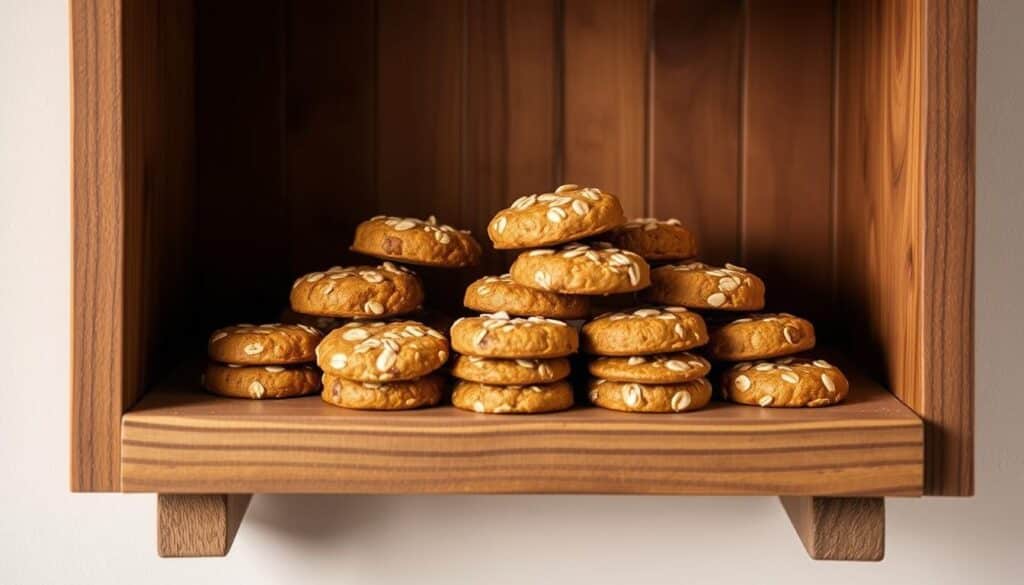Making homemade dog treats lets you pick what goes in them. This helps dogs who are picky or have sensitive stomachs. Pumpkin and oat snacks are made of pumpkin puree, oats, and something to hold them together like eggs or a chia “egg”. These ingredients are easy on most dogs’ tummies.
This guide shows you a simple mix: 3 cups rolled oats, 1 cup pumpkin puree, and 2 eggs. First, turn the oats into almost flour using a food processor. Then mix them with the pumpkin and eggs. You can shape the mix by rolling and cutting or by making small patties. Baking them for 14–18 minutes gives you soft treats. If you bake them for 16–18 minutes, they become crunchy snacks.
You can store these treats easily. Keep them in the fridge in a sealed container for up to two weeks if it’s hot, or freeze them to last up to three months. For dogs with food sensitivities, try using mashed sweet potato or a chia egg instead of a regular egg. Remember, always use plain pumpkin, not the kind for pies.
Why Pumpkin and Oats Are Ideal for Sensitive Dogs
Many pet owners look for easy, gentle snacks to help with digestion. Pumpkin and oats are great for calming upset stomachs and providing important nutrients. These natural ingredients help keep treats nutritious and lower the chance of allergic reactions.
Digestive benefits of pumpkin
Pure pumpkin purée is filled with soluble fiber. This aids in managing both diarrhea and constipation. It balances the water in the gut.
Pumpkin also has vitamins A, C, and beta-carotene. These support the immune system and skin health while being low in calories.
Gentle fiber and nutrients in oats
Oatmeal and oat flour are gentle carbs that are easy for dogs to digest. They are especially good for sensitive stomachs because they provide lasting energy and aid digestion. Oats are ideal in recipes meant for dogs with allergies.
Low-risk ingredients compared to commercial treats
- Homemade recipes give you control over every ingredient, reducing artificial flavors and preservatives.
- Low-risk dog snacks have fewer ingredients, which lessens the chance of reactions compared to some store-bought treats.
- Simple recipes without yeast or rising agents reduce stomach issues and keep snacks healthy.
Pumpkin and oat treats for sensitive dogs
Simple snacks can help avoid stomach upset. They use oats, pure pumpkin, and an egg or a replacement. This mix is short and easy for dogs to digest. Grinding oats into a coarse powder makes them easier on the stomach. Plus, pumpkin adds fiber and water to help with digestion.
How this specific recipe addresses sensitive stomachs
This recipe uses just three ingredients to limit what might upset your dog. Oats provide gentle fiber, pumpkin brings in pectin and moisture, and an egg keeps things together without adding a lot of fat. If your dog can’t have eggs, try chia gel, hemp gel, or mashed banana instead.
Using a coarser oat flour helps with digestion more than whole oats. Starting with soft textures lets you quickly identify any intolerances. This approach makes safe pumpkin oat treats for dogs with sensitive stomachs to try.
Ingredients to avoid for dogs with sensitivities
Avoid instant oatmeal with flavors, pumpkin pie mix, and sweet canned blends. They might have sugar, spices, or xylitol, which are bad for dogs. Also, yeast, baking powder, and complex additives can upset their stomachs.
- Avoid peanut butter unless labeled xylitol-free.
- Skip sweeteners, raisins, chocolate, and nutmeg.
- Do not use pie spices or flavored instant mixes.
Opt for unsweetened, plain pumpkin and natural applesauce as an alternative. Sweet potato or butternut squash can replace pumpkin for some variety.
When to consult your veterinarian before changing treats
Check with your vet before giving new snacks to dogs with chronic stomach issues, allergies, pancreatitis, or kidney disease. Dogs on special diets also need a vet’s okay before getting new treats or foods.
- Ask your vet about treats when you notice chronic vomiting, diarrhea, or weight loss.
- Consult if your dog has documented food allergies or a history of pancreatitis.
- Verify safe dog treat ingredients with your veterinarian for dogs on special diets.
Introduce pumpkin oat treats for sensitive stomachs slowly and watch for any bad reactions. If problems don’t go away, get vet advice quickly on when to ask vet about treats and what to do next.
Simple 3-ingredient pumpkin and oat dog treat recipe
These oat pumpkin dog biscuits are easy and gentle for dogs with sensitive stomachs. You’ll need some common pantry items and a food processor. You can make a firm dough that your dog will adore. This recipe makes about 90 two-inch treats, and each has roughly 14 calories.
Ingredients list with safe substitutions
- 3 cups old-fashioned oats (270 g) — can pulse to make oat flour if preferred.
- 2 large eggs, beaten.
- 1 cup pure pumpkin purée (227 g). Use canned pure pumpkin, not pumpkin pie filling.
- Safe substitutions: replace 1 cup oats with 2 cups oat flour for a finer texture. For a softer variant use 1/2 cup unsweetened applesauce in place of one egg.
Step-by-step preparation using a food processor
- Preheat oven to 350°F and line baking sheets with parchment.
- Process oats 1–2 minutes until they have a near-flour or coarse texture.
- Add pumpkin purée and eggs. Pulse until a sticky but firm dough forms.
- For shaping: use the scoop-and-flatten method for quick rounds or roll and cut shapes.
- Place the pieces on the baking sheets. They can be close as they don’t rise.
Baking times for soft versus crunchy texture
For softer treats, bake 14–16 minutes and turn the pans halfway through. For crunchy ones, bake 16–18 minutes. Make sure their edges are firm. Thicker treats might need 20–25 minutes to get stiff.
Let the treats cool completely on a rack before you serve or store them. They stay fresh in an airtight container in the fridge for a week or can be frozen for longer.
Variations and flavor boosts that remain gentle
Small swaps make homemade snacks fun for picky pups. Change things up but keep it easy on their tummies. That way, treats stay simple to make and kind to their stomachs.
- Choose a certified peanut butter free of xylitol and added sweeteners when making peanut butter dog treats xylitol-free.
- Use 1 tablespoon per batch for a mild hint of flavor, or up to 1/4 cup if you reduce pumpkin by 1/4 cup to keep dough consistency steady.
- Stir peanut butter in well to avoid pockets that can change bake time.
Fruit and veggie swaps
- Mashed banana or unsweetened applesauce can often replace eggs; 1 cup mashed banana or 1/2 cup applesauce works in many recipes.
- Cooked, mashed sweet potato or butternut squash serve as pumpkin alternatives. Expect a slightly thicker batter and add a tablespoon of water if needed.
- For egg-free binding, mix 2 tablespoons chia or hemp seeds with 6 tablespoons water, let gel for five minutes, then fold in.
Optional spices and safety notes
- Use small amounts of safe seasonings to add aroma: 1/4 teaspoon or less of ground cinnamon per batch is usually enough.
- Stick to dog-safe spices and check labels; avoid nutmeg, cloves, and anything labeled “pumpkin pie spice” that may include unsafe ingredients.
- If you try bacon bits as a topper, reserve them for occasional treats; fatty, salty add-ins can upset sensitive stomachs.
Try pumpkin treat tweaks in little batches to see what your dog likes. Keep note of the best mix-ins. And, always check labels for xylitol-free peanut butter before use.
Texture and shaping options for different dogs
It’s easy to shape dog treats. Use simple methods for fast prep and consistent results. Small scoop-and-flatten rounds are good for training and picky dogs. For fun, use cookie cutters to make various shapes that are easy to divide for many dogs.
- Drop-style: scoop dough with a small cookie scoop, place on parchment, flatten lightly with a fork. Dust the scoop with oat flour to prevent sticking.
- Roll and cut: roll dough between parchment to about 1/8″ for standard treats, or 1/4″ for thicker ones. Use a 2″ cutter for about 90 treats from a basic batch.
Choose thickness based on your dog’s chewing ability. Thin, 1/8″ rounds cook quickly and are crispy. Thicker, 1/4″ cutouts keep their shape better and are great for medium chewers.
Bake-time guidance:
- For soft treats, ideal for older dogs, bake 14–16 minutes. Bake them just until they’re set for a tender texture.
- For crunchier snacks, bake 16–18 minutes, or until the edges brown. Thick cutouts might need 20–30 minutes to harden fully.
Snack sticks are another great choice. Make 4–5″ by 1/2″ logs for pumpkin oat snack sticks. Bake them 20–25 minutes for a chewy texture. For very soft sticks, bake less. Bake 5 minutes more for crunchy sticks.
Choose the treat’s hardness based on what your dog likes. Soft treats and pumpkin oat snack sticks are good for gentle chewers. Harder snacks are great for dogs that love to chew. They also help keep teeth healthy when used right.
Storage, shelf life, and freezing tips
Homemade pumpkin and oat treats are fresh, simple, and have no preservatives. This means they need to be stored carefully to stay safe and tasty. Here are some quick tips on storing homemade dog treats, extending their shelf life, and having them ready for training or as cool treats in summer.

Refrigeration best practices and expected freshness
After cooling, put treats in an airtight container or a resealable bag and then refrigerate. In places that are warm or humid, these treats can stay fresh in the fridge for up to two weeks. In cooler indoor areas, they might be okay on the counter for a day or two. But it’s always safer to refrigerate them after that.
For softer snacks, storing them in an airtight container with a paper towel helps maintain their texture. It’s good to check the treats every day for any bad smells or changes in how they feel when you open the container.
How to freeze and thaw for long-term storage
Freezing is a great way to keep extra treats. First, freeze them on a tray until they are solid. Then, move them to a sealed container or freezer bag to stop freezer burn. This method lets you freeze treats for up to three months without much loss in quality.
Thaw treats in the fridge or leave them out at room temperature for an hour. On warm days, giving your dog partially frozen treats can be a nice cool snack. Remember to label containers with the date, so you use the oldest ones first.
Signs homemade treats have gone bad
Always check a snack before giving it to your dog. Throw away any treat that smells bad, has mold, feels slimy, or looks discolored. If a treat tastes or smells sour, it’s not safe for your dog.
If your dog gets sick suddenly after eating a treat, don’t give them any more from that batch. Talk to your vet right away. When you’re unsure, it’s best to throw it out to keep your pet safe.
- Short-term: airtight container in fridge for up to 1–2 weeks depending on climate.
- Long-term: freeze dog treats for up to 3 months in sealed containers.
- Shelf life pumpkin treats will vary with moisture and ingredients; keep records to avoid guesswork.
Ingredient sourcing and equipment recommendations
Choosing the best ingredients and tools is key for baking for dogs with allergies. Look for clear labels and brands you trust when buying. Making smart choices helps create a consistent texture and keeps the treats easy on their stomachs.
Choosing pure pumpkin
Get 100% pure pumpkin purée, not the pie filling kind. Look for brands like Libby’s or organic ones that list just pumpkin. Using only pure pumpkin puree in dog treats avoids extra sugars and spices that can upset dogs.
Best oats and how to make oat flour at home
Old-fashioned rolled oats give treats the right texture. You can use quick-cook oats if needed, but never steel-cut or flavored oats. To make oat flour, just blend rolled oats until they’re fine. This makes the dough bind well without using wheat flour. For the best results, grind oats until they’re almost as fine as flour.
Helpful tools for consistent baking
- Cuisinart Elemental 8-Cup food processor for grinding oats and mixing dough—great for speed and power.
- Nordic Ware half-sheet pans and parchment paper ensure even baking and make cleanup easy.
- A sturdy rolling pin and bone-shaped cookie cutters for fun, different-sized treats.
- Using a small cookie scoop keeps treat sizes the same, and a wire rack helps them cool without becoming soggy.
Shop smart and check labels
Search for unsweetened, organic pumpkin purée and plain oats. Pick natural, xylitol-free peanut butter and unsweetened applesauce for substitutions. You can find affordable cutters and parchment at Walmart or Amazon. These help make your treats uniform without breaking the bank.
Final prep tips
Set up pans with parchment, scoop dough with a small scoop, and cool treats on a wire rack. Following these simple steps, using the right items, baking gentle, homemade snacks becomes a breeze. Knowing how to make oat flour and having the best tools ensures safe, consistent treats for pets.
Health and safety considerations for sensitive pups
Making treats at home? Safety and clear steps are key. Use plain pumpkin puree, rolled oats, and vet-approved binders for dogs with allergies. Remember to track how many calories they get. Homemade snacks spoil faster than store-bought ones because they don’t have preservatives.
Common allergens and how to test for sensitivities
Introduce one new ingredient at a time. Follow your vet’s advice for an elimination diet, which means taking out suspected allergens for weeks, then slowly bringing them back. To pinpoint allergies, your vet might suggest tests like blood panels or special diet trials.
Portion control and caloric considerations
Keep snack sizes small. A small pumpkin-and-oat biscuit might have about 14 kcal. Bite-sized treats can have around 40 kcal each. Follow guidelines to ensure treats don’t exceed 10% of their daily calories. You may need to adjust their main meals too.
When homemade treats are not appropriate
Some dogs need special diets. If your dog has pancreatitis, kidney disease, or is on a special diet, check with your vet first. This will help avoid any issues with treats and their health needs.
- Replace eggs with mashed banana or unsweetened applesauce for egg allergies.
- Never use pumpkin pie filling or flavored instant oats.
- Avoid xylitol-containing peanut butter; choose pure, unsweetened brands.
Keep treats in the fridge or freezer and remember to label them. Look out for any bad smells, changes in texture, or mold. Stop the treats and see a vet if your dog gets sick or has skin issues. By testing carefully and controlling portions, we can keep sensitive dogs safe and happy.
Conclusion
Pumpkin and oat treats are great for dogs with sensitive tummies. They’re made with simple ingredients like pure pumpkin and oat flour. These treats are cheap and you can switch ingredients safely, using unsweetened applesauce or mashed banana.
This recipe is good for dogs because it has few ingredients. That means it’s less likely to upset their stomachs. Plus, it offers fiber, vitamins, and gentle nutrition.
Making these treats is easy if you have a food processor, parchment, and a baking sheet. Unlike treats for people, these won’t puff up in the oven. So, how you shape them and how long you bake them decides their texture. This makes them perfect for dogs of all ages and chewing habits.
If you make a lot at once, you can keep them fresh. Store them in the fridge if you’re using them soon. Or freeze them for later.
You can add things like xylitol-free peanut butter or a little cinnamon for flavor. Just use these extra ingredients carefully. If your dog has health issues, talk to your vet before adding these treats to their diet regularly. When done correctly, pumpkin and oat treats are a tasty, nutritious, and safe choice for sensitive dogs.
FAQ
What are the basic ingredients and measurements for the 3-ingredient pumpkin and oat treats?
Can I substitute any ingredients for allergies or preferences?
What oats should I use and how do I prepare them?
How do I shape the treats and what tools are helpful?
What oven temperature and bake times should I use for soft or crunchy treats?
How many treats does the recipe yield and what is the calorie count?
Which add-ins are safe to keep the treats gentle for sensitive dogs?
Are peanut butter and applesauce safe in these recipes?
How should I store homemade pumpkin and oat treats and how long do they last?
What signs indicate homemade treats have gone bad?
Can dogs with digestive issues or medical conditions eat these treats?
How do I test my dog for sensitivities to new treat ingredients?
Are homemade pumpkin and oat treats nutritionally useful or just a snack?
Can I make the treats chewier or into snack sticks for longer-lasting chews?
Should I avoid any commercial ingredients when sourcing pumpkin or other add-ins?
What equipment do I need to make these treats reliably?
Content created with the help of Artificial Intelligence.



